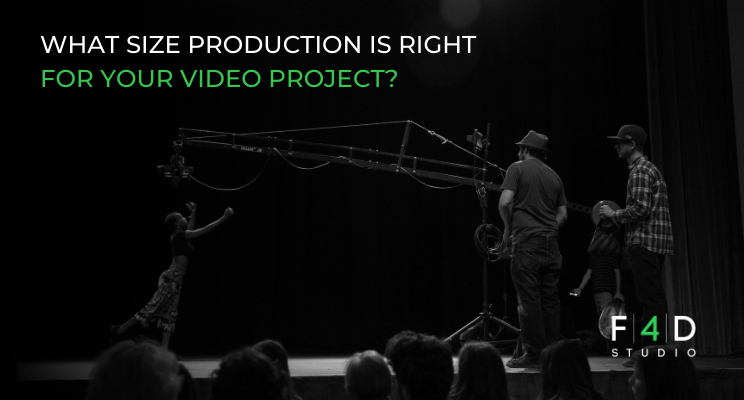
Concept Development
If you have not joined the 81% of businesses using videos to promote their companies, consider updating your marketing strategy before you get left in the dust. When most of our clients contact us, they have a general idea of the message they want portrayed through a video. However, for organizations new to creating a video, you might need our help expressing your project ideas on paper before pressing record.
The Process
Once a client conveys their project goals, the concept development process begins. This typically starts when we share the client’s general goals with the F4D Studio team during one of our morning meetings. Next, we schedule a time for a more in-depth meeting, allowing everyone time to brainstorm individually. During our concept and development meeting we all collaborate to create the strongest ideas that we will later pitch to the client. After the client gives the green light, we need to determine what additional roles will be required throughout pre-production, production, and post-production.
Roles of pre-production
- Copywriter
- Producer
- Director
- Assistant Director
- Director of Photography
- Lighting Designer
- StoryBoard Artist
- Set Designer / Art Department
- Location Scout
- Wardrobe Stylist / Costume Designer
- Casting Director
One of the biggest pre-production questions we need to know is: What platform(s) will this project be released on? This is a great starting point for us to determine the size of the project. There are many different ways to consume media, and each platform has specific time restraints. This is a critical factor that determines how much time we have to get your key messages across to the viewer. Over the past year we have created videos suitable for an array of media including but not limited to:
10 Second Banner Advertisements
15 Second Instagram Stories
30 – 60 Second social media videos
1:30 – 3-Minute Brand Videos for Business Websites, Facebook, and LinkedIn
10-Minute Documentary
60-Minute Feature-Length Documentary
AMOUNT OF PEOPLE ON SET
Moving a project into production is where all the planning pays off. Depending on the project, crews can range from one person to more than 20 people. This all really depends on what the client is trying to achieve, if there are scripted lines, and the project budget.
In our experience, sometimes having a small, 6-person crew on set is optimal because it is easier to maintain clear communication and make sure everyone knows their roles. In this sense, a smaller crew can be easier to manage opposed to wrangling a 20+ person crew. Of course, sometimes having a larger crew is necessary for commercial or complex film shoots because there are more roles to fill.
In today’s world, where COVID-19 is a huge concern, keeping crew size as small as possible to limit potential exposure is our top priority. Finding an indoor set location with maximum airflow or shooting outside is a necessary precaution for everyone’s safety. Limiting the amount of people on set can mean that smaller crews have to take on more than one role, so finding a balance between safety and efficiency is crucial. Overall, finding the sweet spot in terms of crew size helps production run smoothly.
PRODUCTION ROLES:
- Producer
- Director
- Assistant Director
- Director of Photography
- Script Supervisor
- Digital Imaging Technician
- On Set Photographer
- Camera Operator
- Assistant Camera
- Gaffer
- Key Grip
- Audio Technician
- Set Designer / Art Department
- Production Assistant
- Hair and Makeup Artist
- Wardrobe Stylist
- Catering / Craft Services
BUDGET
When it comes to creating an estimate, we start by considering which crewmembers, both in-house and outsourced, are needed to create the best product possible. It is important to think about each step of the production process (preproduction, production, and post-production) and whether we will need to hire outside crew or rent any equipment. From here we create an outline detailing each role, the final deliverable, and the total cost of the proposed project. We do our best to create a fair estimate that works within your budget, but if the proposal causes sticker-shock we work with you to find innovative ways to reduce cost.
POST PRODUCTION
Post-Production is the final stage, where the raw footage is turned into a polished final product. For larger projects we have an assistant editor pull clips and b-roll for the senior editor, who will build the overall edit. There are many things to consider when planning post-production. Was a green screen used? Does the video require motion graphics? If so, we need to include our motion graphics artist on the project, who we will be in communication with during pre-production. What music is best for the project? We can either source our music library or hire one of our trusted composers to record music specifically for the project. Once the edit is in picture lock, we send it to our colorist who not only color balances the footage but stylizes the project specific to your look or brand. Typically, there are two rounds of revisions at client request before we deliver the polished deliverable.
Roles of Post-Production:
- Director
- Producer
- Editor
- Assistant Editor
- Colorist
- Composer
- Music Supervisor
- Graphic Designer
- Motion Graphic Artist / Visual FX
- Sound Design and Sound Effects

Recent Comments